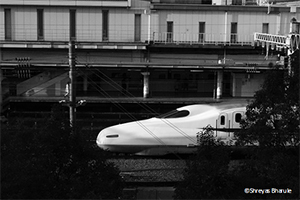
In 1969, Professor Edward Norton Lorenz coined the term “butterfly effect” to state that subtle changes in conditions can influence or cause seemingly unrelated results elsewhere. The flutter of a butterfly’s wings at place A can eventually develop into a hurricane at place B even though A and B are not related. Almost two decades after the term was coined, Japan National Railways (JNR) was privatized and split into several corporations, and now JR East manages the largest network of railway lines in Japan. JR East also runs the longest shinkansen (high-speed rail) line in Japan and has cut the travel time between the historical economic centres of Japan. Over a period of 50 years, the shinkansen line, along with major highways, has become the spine of one of the most important regional economic belt developments in the world.
A city can be imagined as a complex organism with interlinked functions. For instance, urban life in any city is extremely intertwined, and the interdependencies of networks of activities are endless. A high-speed rail (HSR) line is one such link connecting important hubs through networks of cities. There has been a growing awareness in the governments of various nations about how vital it is to start thinking more strategically in ways to encourage growth and wellbeing while reducing regional disparity, divides, and polarization.
ADBI hosted the first two of a series of seminars on Planning, Implementation, and Operating High-Speed Railways in Asia. The seminars brought together experts from ADBI and other eminent institutions who have been researching aspects related to HSR development. The sessions identified the impacts and effects of HSR introduction in different parts of Asia. The discussions on the spill-over effects of infrastructure investments such as HSR indicated impacts ranging from infrastructure development associated with HSR development and the environmental implications of HSR to economic development, which may occur due to HSR implementation.
Globally, HSR is considered among the most expensive and premium forms of infrastructure, but the challenges and opportunities related to the planning and implementation of infrastructure vary from country to country. Despite such local variations, almost all HSR-operating countries have reported a dynamic change in various other urban systems associated with HSR within only a few years of its inauguration.
Some common themes of discussion emerged from the seminars, suggesting the multiple impact association of HSR lines with respect to implementation in the regional context. Several models of integrated land development and railway operation have been implemented in Japan since the early 1900s. They have resulted in better economic development of the cities served by the shinkansen corridors, suggesting the interdependence of the implementation and planning process. The Republic of Korea has followed a very similar model of development but requires additional efforts in integrating the regional public transport to the KTX corridors and stations to enhance revenue. The case of THSRC, an HSR corporation in Taipei,China, is especially unique. After becoming almost bankrupt, the company has resurrected itself in the past 10 years by making meticulous efforts to streamline the operations and sustainability of the HSR.
Academic studies about HSR and urban interactions suggest that with the introduction of an HSR corridor, the accessibility of the HSR influence in the region is transformed over time. A session dedicated to the relatively less explored subject of station area development brought light to issues related to the high-speed rail stations. Being the gateways where passengers from the HSR meet the city, stations are important components not only for the planning and design of an HSR project but also for creating and enhancing the image of a city as well.
The presentations and discussions suggested the common point that the success of an HSR investment is heavily dependent on collaboration and cooperation amongst the various public and private sector stakeholders. Other important aspects associated with successful HSR implementation are the gathering, sharing, and analysis of data, which are crucial for ensuring that urban systems flourish. An additional compelling point is that HSR is only a component of city infrastructure, and it must be tied to processes and policies that govern urban life.
The complete process for declaring an HSR system’s success usually takes over a decade. Keeping this in mind, having a vision of the desired future development is essential. Having said that, meticulous planning of the entire implementation procedure can also be termed as an essential component of the vision. Also, since the whole implementation process involves multiple stakeholders, actors, and steering members, engaging all of them in discussions is of paramount importance.
As, such the mysteries of the “butterfly effect” of HSR investment must be investigated at multiple levels to optimize and find the best possible fit for implementation.







Comments are closed.